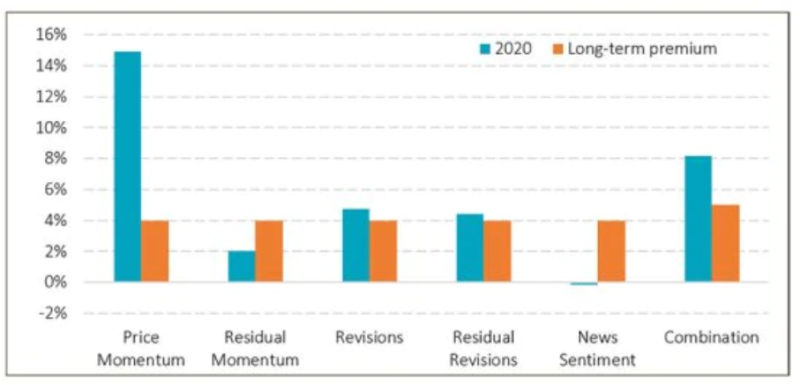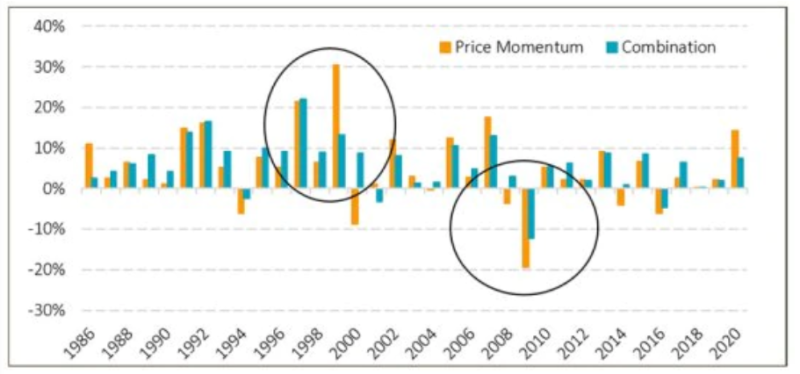Momentum was one of the top-performing factors in 2020. Indeed, the MSCI ACWI Momentum Index did not only significantly beat the MSCI ACWI, but it also outperformed most factor indices. It benefited from its material exposure to mega-cap growth stocks, in particular its large allocation to ‘big tech’. To this end, the MSCI ACWI Momentum and MSCI ACWI Growth Indices had material overweight exposures to seven of the ten largest stocks in the MSCI ACWI: namely Apple, Microsoft Corporation, Amazon, Tesla, Taiwan Semiconductor Manufacturing Company, Alibaba Group Holding and Tencent.1
That said, it was not all smooth sailing as the factor navigated an uneven performance path in 2020. Its ride was punctuated by bumpy occasions during periods of strong reversals characterized by growth stocks retreating. From mid-May until early June, during the first half of September, and – most recently – since 9 November 2020, growth stocks lagged the market, significantly reducing the MSCI ACWI Momentum Index’s year-to-date outperformance during those intervals.
“
It was not all smooth sailing as the factor navigated an uneven performance path in 2020
In fact, the most evident indication of a value-growth rotation occurred after the announcement of positive phase III clinical trial results for the Pfizer-BioNTech vaccine-candidate in November. Given its heavy tilt towards large-cap growth equities and underweight exposure to smaller-cap value stocks, the MSCI ACWI Momentum Index was severely affected by the news and the subsequent rally of the value factor. Despite that, the style capped off the year as one of the top-performing factors in 2020.
Quite interestingly, we also observed large return dispersions between different momentum strategies over the period. The results are illustrated in Figure 1, where the blue bars depict the 2020 portfolio returns of various momentum signals relative to their long-term expectations.2 The chart shows that the price momentum factor had an outstanding year, exceeding not only its own long-term average, but also outperforming all the other momentum signals.
Figure 1 | 2020 and long-term performance of Momentum signals in excess of the market

Source: Robeco, FactSet as at November 2020. Figure shows annualized average returns of portfolios constructed based on price momentum, residual momentum, analyst revisions, residual analyst revisions and news sentiment. The investment universe consists of constituents of the MSCI ACWI augmented with large and liquid constituents of the FTSE World Developed, the S&P Broad Market, and the IFC Investable Emerging Markets Index. Portfolios are constructed by investing in securities ranked in the top 20% of the respective signal and they are rebalanced monthly. Combination portfolio is based on the combined ranked where the signals are equal-weighted. Long-term average returns based on the 1986-2020 sample period (2001-2020 for news sentiment).
The picture, however, is a bit different when viewed from a longer-term perspective. Figure 2 shows the calendar-year returns of price momentum and an equal-weighted combination of momentum signals based on a historical sample. The graph reveals that a combined approach delivers higher average returns, and, importantly, also provides a much smoother ride compared to the traditional price momentum factor. The most notable performance gaps took place around significant momentum peaks (e.g. height of dot-com bubble) and momentum drawdowns (e.g. such as 2009).
Figure 2 | Calendar-year returns of Price Momentum and a combination of five Momentum signals

Source: Robeco, FactSet as at November 2020. Figure shows calendar-year returns of portfolios constructed based on price momentum and a combination of price momentum, residual momentum, analyst revisions, residual analyst revisions and news sentiment. The investment universe consists of constituents of the MSCI ACWI augmented with large and liquid constituents of the FTSE World Developed, the S&P Broad Market, and the IFC Investable Emerging Markets Index. Portfolios are constructed by investing in securities ranked in the top 20% of the respective signal and they are reformed monthly.
Apart from the diversification benefits derived from combining different momentum signals, the risk reduction observed stemmed from avoiding large style bets, that typically accompany traditional price momentum. These bets are, on average, unrewarded, and nearly half of the total volatility associated with traditional price momentum strategies can be attributed to them.3
Portfolio construction parameters are another source of significant return dispersion between different momentum approaches. Most notably is the allocation to mega and large-cap stocks versus smaller-cap counterparts. Several studies show that momentum is stronger in mid- to smaller-cap equities. The efficacy of the factor is reinforced by tilting it towards smaller stocks.4
Momentum can, at times, be exposed to significant style and concentration risks. Its current exposure to large-cap growth stocks that trade at lofty valuations is a good example. We believe that a well-diversified portfolio approach across momentum signals is prudent. It avoids concentrated positions and is less affected by the dynamic tilts that traditional price momentum can adopt to other factors, thereby mitigating those risks.
In our view, combining momentum with other factors has been and continues to be an effective way to improve long-term investment outcomes. Although such choices can result in headwinds at times, we believe that being cognizant of momentum’s properties, and taking them into account when designing a momentum or a multi-factor strategy, leads to better performance in the long term.
クオンツに関する最新の「インサイト」を読む
ロベコのニュースレターにご登録いただくことで、いち早く最新のインサイトを入手し、環境に優しいポートフォリオの構築にお役立てください。
重要事項
当資料は情報提供を目的として、Robeco Institutional Asset Management B.V.が作成した英文資料、もしくはその英文資料をロベコ・ジャパン株式会社が翻訳したものです。資料中の個別の金融商品の売買の勧誘や推奨等を目的とするものではありません。記載された情報は十分信頼できるものであると考えておりますが、その正確性、完全性を保証するものではありません。意見や見通しはあくまで作成日における弊社の判断に基づくものであり、今後予告なしに変更されることがあります。運用状況、市場動向、意見等は、過去の一時点あるいは過去の一定期間についてのものであり、過去の実績は将来の運用成果を保証または示唆するものではありません。また、記載された投資方針・戦略等は全ての投資家の皆様に適合するとは限りません。当資料は法律、税務、会計面での助言の提供を意図するものではありません。 ご契約に際しては、必要に応じ専門家にご相談の上、最終的なご判断はお客様ご自身でなさるようお願い致します。 運用を行う資産の評価額は、組入有価証券等の価格、金融市場の相場や金利等の変動、及び組入有価証券の発行体の財務状況による信用力等の影響を受けて変動します。また、外貨建資産に投資する場合は為替変動の影響も受けます。運用によって生じた損益は、全て投資家の皆様に帰属します。したがって投資元本や一定の運用成果が保証されているものではなく、投資元本を上回る損失を被ることがあります。弊社が行う金融商品取引業に係る手数料または報酬は、締結される契約の種類や契約資産額により異なるため、当資料において記載せず別途ご提示させて頂く場合があります。具体的な手数料または報酬の金額・計算方法につきましては弊社担当者へお問合せください。 当資料及び記載されている情報、商品に関する権利は弊社に帰属します。したがって、弊社の書面による同意なくしてその全部もしくは一部を複製またはその他の方法で配布することはご遠慮ください。 商号等: ロベコ・ジャパン株式会社 金融商品取引業者 関東財務局長(金商)第2780号 加入協会: 一般社団法人 日本投資顧問業協会
